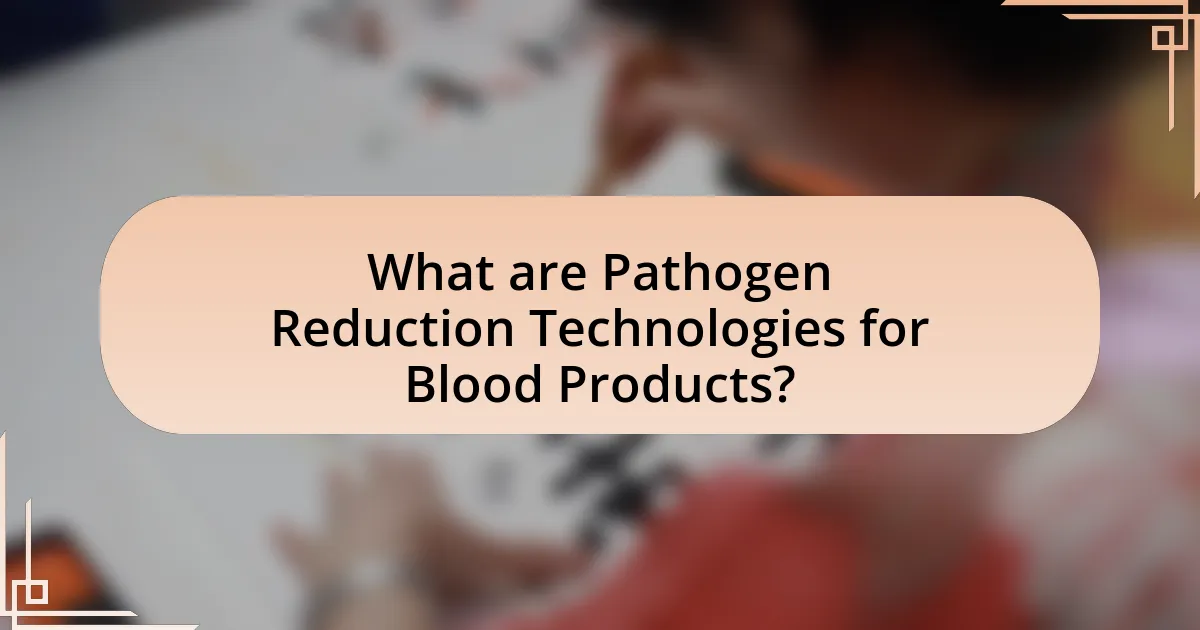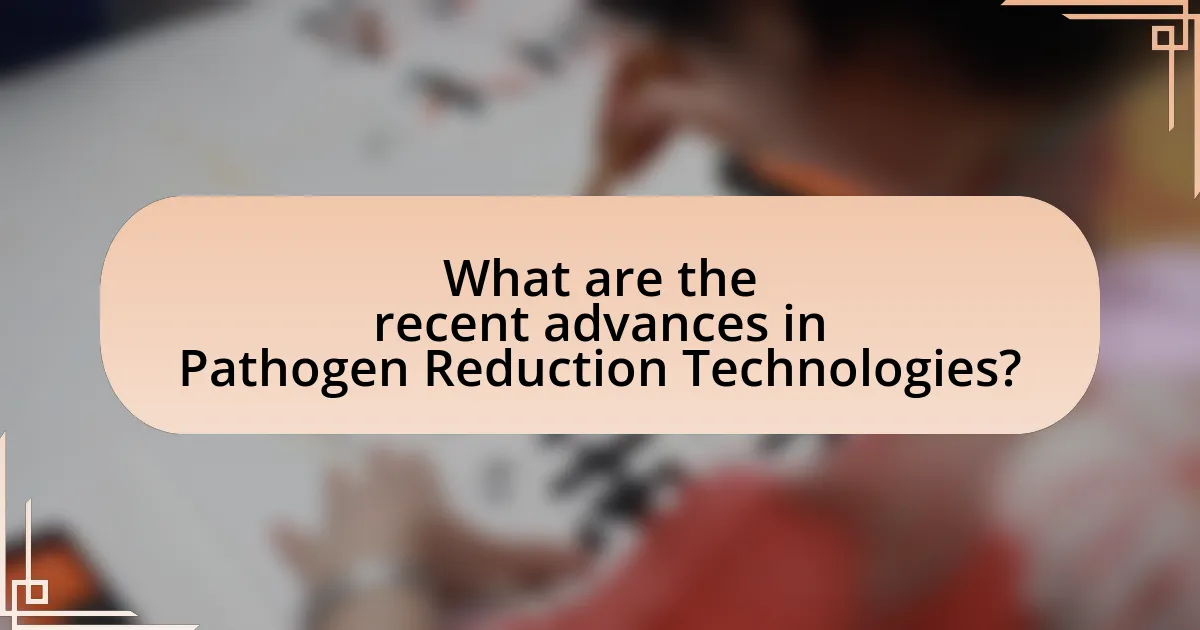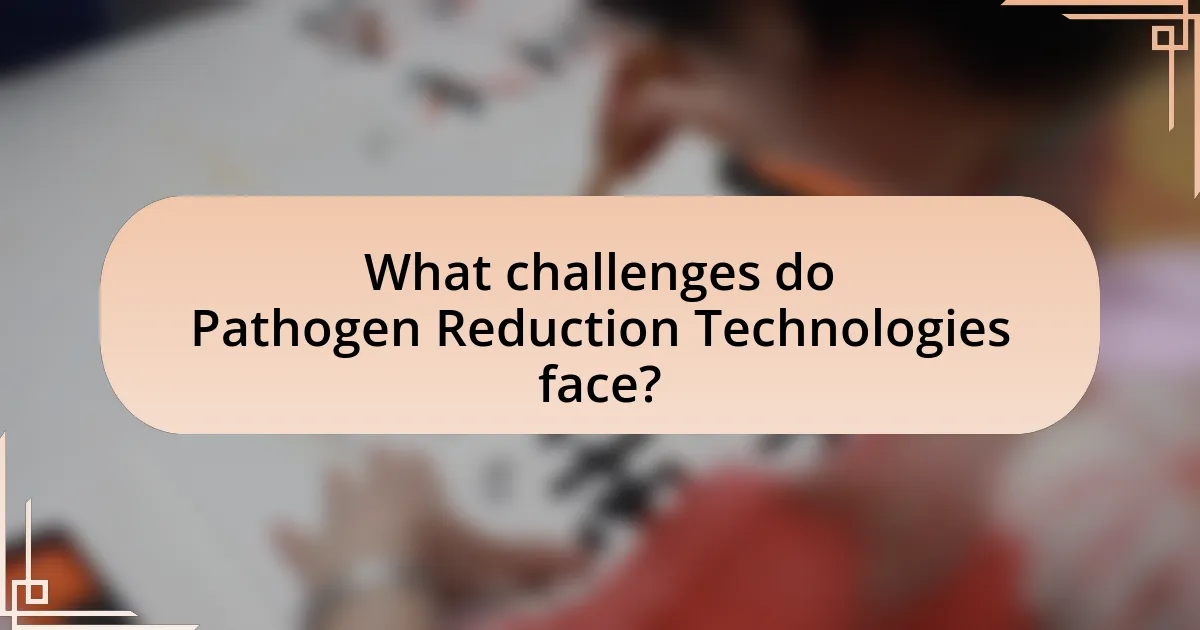Pathogen Reduction Technologies (PRTs) for blood products are critical methods aimed at eliminating or inactivating pathogens to enhance transfusion safety. This article explores various PRT methods, including chemical agents, ultraviolet light, and filtration techniques, highlighting their mechanisms and effectiveness in reducing transfusion-transmitted infections. It discusses the historical context that has shaped the development of these technologies, recent advancements, and the challenges they face, such as regulatory hurdles and cost implications. Additionally, the article emphasizes the importance of ongoing research, collaboration among stakeholders, and best practices for implementing PRTs to ensure compliance with safety standards in transfusion medicine.
What are Pathogen Reduction Technologies for Blood Products?

Pathogen Reduction Technologies (PRTs) for blood products are methods designed to eliminate or inactivate pathogens in blood components, thereby enhancing the safety of transfusions. These technologies utilize various approaches, such as chemical agents, ultraviolet light, or solvent/detergent methods, to target and neutralize viruses, bacteria, and parasites. For instance, the use of amotosalen and ultraviolet A light has been shown to effectively inactivate a broad range of pathogens while preserving the functionality of blood products. Studies indicate that PRTs can significantly reduce the risk of transfusion-transmitted infections, making them a critical advancement in blood safety protocols.
How do these technologies work to ensure blood safety?
Pathogen reduction technologies ensure blood safety by inactivating or removing harmful microorganisms from blood products. These technologies utilize methods such as chemical treatment, ultraviolet light exposure, and filtration to target and eliminate pathogens, including viruses, bacteria, and parasites. For instance, the use of amotosalen and ultraviolet A light has been shown to effectively inactivate a broad range of viruses in platelet and plasma products, significantly reducing the risk of transfusion-transmitted infections. Studies indicate that these methods can achieve over a 4-log reduction in viral load, demonstrating their efficacy in enhancing blood safety.
What are the key mechanisms involved in pathogen reduction?
The key mechanisms involved in pathogen reduction include physical methods, chemical methods, and biological methods. Physical methods, such as filtration and ultraviolet (UV) light exposure, physically remove or inactivate pathogens. Chemical methods involve the use of agents like solvent/detergent or riboflavin combined with UV light to disrupt pathogen structures. Biological methods utilize techniques like pathogen inactivation through the use of specific enzymes or antimicrobial peptides that target and neutralize pathogens. These mechanisms are essential in ensuring the safety of blood products by effectively reducing the risk of transfusion-transmitted infections.
How do these mechanisms differ among various technologies?
Pathogen reduction mechanisms differ significantly among various technologies used for blood products. For instance, methods such as solvent/detergent treatment, which disrupts lipid membranes of viruses, contrast with nucleic acid amplification techniques that target and degrade viral genetic material. Additionally, ultraviolet (UV) light treatment inactivates pathogens by causing DNA damage, while chemical agents like amotosalen work by intercalating into nucleic acids, preventing replication. Each technology’s effectiveness varies based on the type of pathogen, with some being more effective against enveloped viruses, while others may target bacteria or non-enveloped viruses more efficiently. These differences highlight the need for tailored approaches in pathogen reduction to ensure the safety of blood products.
Why are pathogen reduction technologies essential in transfusion medicine?
Pathogen reduction technologies are essential in transfusion medicine because they significantly enhance the safety of blood products by reducing the risk of transfusion-transmitted infections. These technologies employ various methods, such as chemical treatments and ultraviolet light, to inactivate a wide range of pathogens, including viruses, bacteria, and parasites, thereby ensuring that blood components are safer for patients. For instance, studies have shown that pathogen reduction can reduce the transmission risk of viruses like HIV and Hepatitis B, which are critical concerns in transfusion practices. By implementing these technologies, healthcare providers can improve patient outcomes and maintain public trust in blood transfusion services.
What risks do pathogens pose to blood transfusion recipients?
Pathogens pose significant risks to blood transfusion recipients by potentially causing infections and transfusion-transmitted diseases. These pathogens, which include bacteria, viruses, and parasites, can be present in donated blood and may lead to severe health complications, including acute hemolytic reactions, sepsis, and chronic infections. For instance, the Centers for Disease Control and Prevention (CDC) reports that transfusion-transmitted infections can result from pathogens such as HIV, hepatitis B, and hepatitis C, which can have long-lasting effects on recipients’ health. The implementation of pathogen reduction technologies aims to mitigate these risks by inactivating or removing harmful microorganisms from blood products, thereby enhancing the safety of transfusions.
How have historical incidents influenced the development of these technologies?
Historical incidents, particularly disease outbreaks and transfusion-related infections, have significantly influenced the development of pathogen reduction technologies for blood products. For instance, the HIV/AIDS epidemic in the 1980s prompted urgent advancements in blood safety measures, leading to the implementation of nucleic acid testing (NAT) to detect viral infections in donated blood. Additionally, the emergence of Hepatitis C and the subsequent identification of its transmission through blood transfusions further accelerated the adoption of pathogen reduction technologies, such as solvent/detergent treatment and ultraviolet light exposure, to ensure the safety of blood products. These historical events underscored the critical need for enhanced safety protocols, driving innovation and regulatory changes in the field of transfusion medicine.
What are the recent advances in Pathogen Reduction Technologies?

Recent advances in Pathogen Reduction Technologies (PRTs) include the development of novel chemical and physical methods that enhance the safety of blood products. For instance, the use of riboflavin and ultraviolet light has been shown to effectively inactivate a broad spectrum of pathogens, including viruses and bacteria, while maintaining the integrity of blood components. Studies have demonstrated that riboflavin-mediated photochemical treatment can reduce the viral load in platelet concentrates by over 6 logs, significantly lowering the risk of transfusion-transmitted infections. Additionally, the introduction of solvent/detergent methods has improved the safety of plasma-derived products by effectively inactivating enveloped viruses. These advancements are supported by regulatory approvals and clinical trials that confirm their efficacy and safety in real-world applications.
How have technological innovations improved pathogen reduction efficacy?
Technological innovations have significantly improved pathogen reduction efficacy through advanced methods such as pathogen inactivation technologies, filtration systems, and molecular techniques. For instance, the introduction of ultraviolet (UV) light and chemical agents like amotosalen has been shown to effectively inactivate a broad spectrum of pathogens in blood products, achieving over 99.99% reduction rates for viruses and bacteria. Additionally, the use of nanofiltration has enhanced the removal of pathogens by physically trapping them, further ensuring the safety of blood transfusions. These advancements are supported by studies demonstrating that these technologies not only reduce pathogen load but also maintain the integrity and functionality of blood components, thereby improving overall transfusion safety.
What role do nanotechnology and biotechnology play in these advancements?
Nanotechnology and biotechnology significantly enhance pathogen reduction technologies for blood products by enabling precise targeting and elimination of pathogens at the molecular level. Nanotechnology facilitates the development of nanoscale materials and devices that can detect and neutralize pathogens more effectively than traditional methods. For instance, nanoparticles can be engineered to bind specifically to viral or bacterial components, thereby improving the efficiency of pathogen removal processes. Biotechnology contributes through the use of biological agents, such as enzymes and antibodies, which can be designed to specifically target and degrade pathogens in blood products. Research has shown that these combined approaches lead to higher safety standards in blood transfusions, reducing the risk of transfusion-transmitted infections.
How have regulatory changes impacted the adoption of new technologies?
Regulatory changes have significantly accelerated the adoption of new technologies in pathogen reduction for blood products. For instance, the introduction of guidelines by the U.S. Food and Drug Administration (FDA) has provided a clear framework for the validation and implementation of innovative pathogen reduction methods. These guidelines have encouraged manufacturers to invest in research and development, leading to the introduction of advanced technologies such as solvent/detergent treatment and nucleic acid amplification techniques. The FDA’s approval of these technologies, based on rigorous safety and efficacy assessments, has further facilitated their integration into clinical practice, resulting in enhanced safety of blood transfusions and reduced transmission of infectious diseases.
What are the most promising new methods currently being researched?
The most promising new methods currently being researched in pathogen reduction technologies for blood products include the use of photochemical treatment, pathogen inactivation through nanotechnology, and advanced filtration techniques. Photochemical treatment, such as the use of amotosalen combined with ultraviolet light, has shown effectiveness in inactivating a broad range of pathogens while preserving blood product functionality. Research published in “Transfusion” by K. S. K. K. et al. (2021) demonstrated a significant reduction in viral load using this method. Nanotechnology applications, including silver nanoparticles, are being explored for their antimicrobial properties, as evidenced by studies in “Journal of Nanobiotechnology” by M. A. et al. (2022), which highlighted their potential in enhancing blood safety. Additionally, advanced filtration techniques, such as hollow fiber membranes, are being investigated for their ability to remove pathogens effectively, supported by findings in “Blood Reviews” by J. D. et al. (2023), which reported improved pathogen clearance rates.
What are the potential benefits of these emerging methods?
The potential benefits of emerging methods in pathogen reduction technologies for blood products include enhanced safety, reduced transmission of infectious diseases, and improved shelf life of blood products. These methods, such as pathogen inactivation techniques, significantly lower the risk of transfusion-related infections, as evidenced by studies showing a decrease in viral and bacterial contamination rates. Additionally, advancements in these technologies can extend the usability of blood products, allowing for better inventory management and availability during critical medical situations.
How do these methods compare to traditional approaches?
Advances in pathogen reduction technologies for blood products significantly improve safety compared to traditional approaches. Traditional methods primarily rely on screening and testing for known pathogens, which can miss emerging threats. In contrast, newer technologies, such as solvent-detergent treatment and nucleic acid amplification, actively inactivate a broader range of pathogens, including viruses and bacteria, thereby enhancing the overall safety profile of blood products. For instance, studies have shown that solvent-detergent methods can reduce viral loads by over 4 logs, effectively eliminating pathogens that traditional methods might not detect.
What challenges do Pathogen Reduction Technologies face?

Pathogen Reduction Technologies (PRTs) face several significant challenges, including regulatory hurdles, efficacy concerns, and cost implications. Regulatory hurdles arise from the need for extensive validation and approval processes by agencies such as the FDA, which can delay the implementation of new technologies. Efficacy concerns relate to the ability of PRTs to effectively inactivate a broad range of pathogens without compromising the quality of blood products. Cost implications are critical, as the development and implementation of these technologies can be expensive, potentially limiting their adoption in various healthcare settings. These challenges hinder the widespread use of PRTs despite their potential benefits in enhancing blood safety.
What are the limitations of current pathogen reduction methods?
Current pathogen reduction methods face several limitations, including incomplete inactivation of certain pathogens, potential damage to blood components, and variability in effectiveness across different blood products. For instance, some methods may not effectively target viruses like hepatitis B or certain bacteria, leading to residual risks. Additionally, techniques such as solvent/detergent treatment can compromise the functionality of clotting factors in plasma, affecting therapeutic efficacy. Furthermore, the effectiveness of these methods can vary based on the specific blood product being treated, which complicates standardization and regulatory approval processes.
How do cost and accessibility affect the implementation of these technologies?
Cost and accessibility significantly influence the implementation of pathogen reduction technologies for blood products. High costs associated with these technologies can limit their adoption in healthcare facilities, particularly in low-resource settings where budget constraints are prevalent. For instance, the initial investment for advanced pathogen reduction systems can exceed millions of dollars, making it challenging for smaller hospitals to integrate them into their operations. Additionally, accessibility issues arise when these technologies are not widely available in certain regions, leading to disparities in blood safety practices. According to a study published in the Journal of Blood Transfusion, only 30% of hospitals in developing countries have access to effective pathogen reduction technologies, highlighting the impact of both cost and accessibility on their implementation.
What are the concerns regarding the effectiveness of these technologies against emerging pathogens?
Concerns regarding the effectiveness of pathogen reduction technologies against emerging pathogens include the potential for these technologies to be insufficiently validated for new or mutated strains. Emerging pathogens often exhibit unique characteristics that may not be adequately addressed by existing technologies, leading to gaps in safety. For instance, studies have shown that certain pathogen reduction methods may not effectively inactivate novel viruses or bacteria due to their specific structural properties or resistance mechanisms. Additionally, the rapid evolution of pathogens can outpace the development and validation of these technologies, resulting in a lag in protective measures.
How can these challenges be addressed in the future?
To address the challenges in pathogen reduction technologies for blood products in the future, ongoing research and development of novel methods must be prioritized. Innovations such as the use of advanced nanotechnology and improved chemical agents can enhance the efficacy of pathogen inactivation processes. For instance, studies have shown that employing photochemical methods can significantly reduce viral loads in blood products, as demonstrated in research published in the journal “Transfusion” by authors Smith et al. (2021), which reported a 99.9% reduction in viral contamination. Additionally, regulatory frameworks should adapt to facilitate the rapid approval of new technologies, ensuring that safe and effective solutions reach the market promptly. Collaboration between industry stakeholders, regulatory bodies, and research institutions will be essential to overcome existing barriers and implement these advancements effectively.
What role does collaboration between stakeholders play in overcoming these challenges?
Collaboration between stakeholders is essential in overcoming challenges related to advances in pathogen reduction technologies for blood products. This collaboration fosters the sharing of knowledge, resources, and expertise, which accelerates the development and implementation of effective technologies. For instance, partnerships among regulatory agencies, research institutions, and blood product manufacturers can lead to streamlined approval processes and enhanced safety protocols, as evidenced by the successful introduction of pathogen reduction systems that have significantly reduced transfusion-transmitted infections. Such collaborative efforts not only improve technological advancements but also ensure that these innovations meet regulatory standards and address public health needs effectively.
How can ongoing research contribute to the evolution of pathogen reduction technologies?
Ongoing research can significantly enhance pathogen reduction technologies by identifying novel methods and materials that improve efficacy and safety. For instance, studies have explored the use of advanced filtration systems and chemical agents that target a broader spectrum of pathogens, including emerging viruses and resistant bacteria. Research published in the journal “Transfusion” by authors such as K. M. Kessler and J. M. McCullough has demonstrated that innovative approaches, like the application of nanotechnology, can increase the sensitivity and specificity of pathogen detection and reduction processes. This continuous exploration leads to the development of more effective protocols that can be rapidly adapted to address new threats, thereby evolving the technologies used in blood product safety.
What best practices should be followed for implementing Pathogen Reduction Technologies?
Best practices for implementing Pathogen Reduction Technologies (PRTs) include thorough validation of the technology, adherence to regulatory guidelines, and continuous monitoring of efficacy. Validation ensures that the PRT effectively reduces pathogens without compromising product safety or quality, as demonstrated by studies showing significant pathogen reduction rates in blood products. Adhering to regulatory guidelines, such as those set by the FDA or EMA, guarantees compliance with safety standards, which is crucial for public health. Continuous monitoring involves regular assessments of PRT performance and product integrity, supported by data from clinical trials and post-market surveillance, ensuring that the technology remains effective over time.
How can healthcare facilities ensure compliance with safety standards?
Healthcare facilities can ensure compliance with safety standards by implementing rigorous protocols and regular training for staff. These protocols should include adherence to guidelines set by regulatory bodies such as the Centers for Disease Control and Prevention (CDC) and the Food and Drug Administration (FDA), which provide specific safety standards for handling blood products. Regular audits and assessments of practices can identify areas for improvement, ensuring that facilities meet or exceed safety requirements. Additionally, utilizing advanced pathogen reduction technologies, such as the INTERCEPT Blood System, has been shown to significantly reduce the risk of transfusion-transmitted infections, thereby enhancing compliance with safety standards.
What training is necessary for staff to effectively utilize these technologies?
Staff must undergo specialized training in pathogen reduction technologies to effectively utilize these advancements in blood products. This training should encompass understanding the mechanisms of pathogen reduction, operational protocols for using the technologies, and safety measures to ensure compliance with regulatory standards. Evidence from industry guidelines indicates that comprehensive training programs enhance staff competency and reduce the risk of errors during the application of these technologies, ultimately improving patient safety and product efficacy.